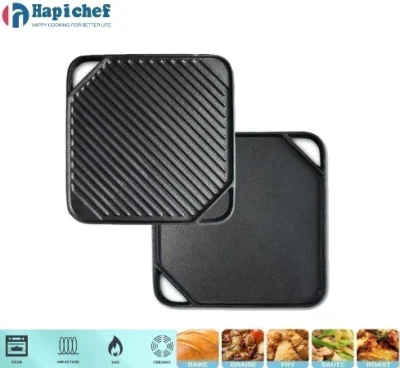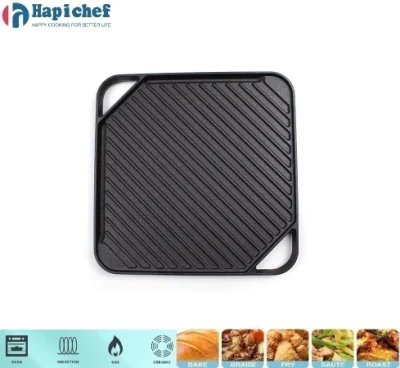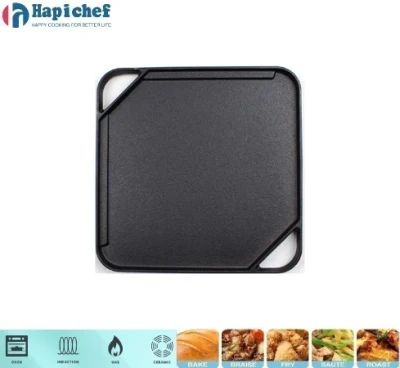Cast Iron Flat Square Pan: Versatile Square Griddle & Grill
Unveiling the Versatility of the Cast Iron Flat Square Pan in Modern Cuisine
In the dynamic world of professional kitchens and gourmet home cooking, the demand for durable, efficient, and versatile cookware is ever-present. Among the myriad options, the cast iron flat square pan stands out as a fundamental tool, renowned for its exceptional heat retention and even heat distribution. This double-sided griddle pan, often referred to as a cast iron griddle square or cast iron square griddle pan, offers unparalleled performance for a wide array of cooking techniques, from searing meats to grilling vegetables and crafting perfect pancakes. Its robust construction ensures a long service life, making it a sustainable and cost-effective investment for culinary professionals and enthusiasts alike.

The increasing popularity of these specialized pans is driven by their ability to deliver consistent results and withstand rigorous use in commercial settings. Unlike traditional rounded pans, the square shape of the cast iron flat square pan maximizes cooking surface area, allowing for greater efficiency when preparing multiple items simultaneously. This article delves into the intricate manufacturing processes, technical specifications, and diverse applications of this essential cookware, providing insights for B2B decision-makers seeking to optimize their kitchen operations with high-performance equipment.
The Unrivaled Craftsmanship: Manufacturing Excellence of Cast Iron Pans
The production of a high-quality cast iron flat square pan involves a meticulous series of processes, primarily rooted in traditional sand casting, combined with modern precision techniques. The journey begins with the creation of a precise mold, often from a mixture of sand and binders, which dictates the pan's final shape and dimensions. Molten iron, typically a high-carbon iron alloy, is then poured into these molds at extremely high temperatures, ranging from 1200°C to 1500°C. This specific material choice is critical for achieving the desirable thermal mass and heat retention properties inherent to cast iron.

After cooling and shakeout, where the cast iron solidifies and the sand mold is broken away, the raw casting undergoes rigorous finishing. This includes grinding to remove excess metal (flashing) and shot blasting to create a uniform surface texture. For some variants, like an enameled cast iron square grill pan, an additional enameling process applies a durable, vitreous coating that enhances aesthetics, provides a non-reactive cooking surface, and simplifies cleaning. Each pan is subjected to stringent quality control, adhering to international standards such as ISO 9001 for manufacturing quality management and food-grade certifications like FDA or LFGB, ensuring safety and performance. This rigorous process guarantees an exceptional product with an impressive service life, often spanning decades with proper care.
Typical Manufacturing Process Flow:
- Pattern Making: Creating a master pattern for the mold.
- Sand Molding: Compacting sand around the pattern to form the mold cavity.
- Melting & Pouring: Heating iron to molten state and pouring into molds.
- Cooling & Shakeout: Allowing iron to solidify and removing the casting from the mold.
- Fettling & Grinding: Removing risers, gates, and surface imperfections.
- Shot Blasting: Cleaning and preparing the surface for seasoning or enameling.
- Seasoning/Enameling: Applying a layer of polymerized oil (for raw cast iron) or enamel coating.
- Quality Inspection: Dimensional checks, material integrity tests, and food-grade compliance.
- Packaging: Preparing the finished griddle pan square for shipment.

Technical Specifications & Performance Data
The performance of a cast iron flat square pan is directly linked to its meticulously engineered technical specifications. Key parameters include dimensions, weight, material composition, and thermal properties, all of which contribute to its superior cooking capabilities. For instance, the pan's thickness directly impacts its thermal mass, dictating how much heat it can absorb and retain, ensuring consistent cooking temperatures across the entire surface. Its compatibility with various heat sources, including induction, gas, electric, ceramic, and even open flames, makes it an exceptionally versatile tool in any kitchen.
| Parameter | Typical Specification for Cast Iron Flat Square Pan |
|---|---|
| Material Composition | High-grade grey cast iron (Fe, C: 3.5-4.0%, Si: 1.5-2.5%, Mn: 0.5-1.0%, P, S trace) |
| Dimensions (L x W) | Typical range: 10x10 inches (25x25 cm) to 14x14 inches (35x35 cm) |
| Weight | Varies by size, typically 3.5 kg to 6.0 kg (7.7 lbs to 13.2 lbs) |
| Wall Thickness | 3.5 mm - 5.0 mm (0.14 - 0.20 inches) for optimal heat retention |
| Heat Resistance | Safe for oven use up to 260°C (500°F) or higher for raw cast iron |
| Thermal Conductivity | Approx. 50 W/(m·K) (excellent heat distribution once heated) |
| Surface Finish | Pre-seasoned vegetable oil finish or durable enamel coating |
| Compliance Standards | FDA, LFGB, ISO 9001 (manufacturing), ASTM A48 (material) |
The dual-sided nature of the Cast Iron Square Double Side Griddle Pan further enhances its utility, typically featuring a flat griddle surface on one side and a ribbed grill surface on the other. This design allows for seamless transition between different cooking styles without requiring multiple pans, saving space and improving efficiency in commercial kitchens. The superior thermal properties of cast iron ensure that food cooks evenly, developing a desirable crust or sear, while its natural seasoning layer, built up over time, contributes to a non-stick surface, reducing the need for excessive oils.

Diverse Applications & Industry Impact
The versatility of the cast iron flat square pan makes it an indispensable asset across various culinary sectors. In commercial restaurants, from steakhouses to breakfast diners, its ability to maintain consistent high temperatures is crucial for achieving perfect sears on meats, crispy bacon, and fluffy pancakes. The large, flat cooking surface of a griddle pan square is ideal for high-volume production, enhancing kitchen throughput and efficiency during peak hours. Beyond traditional restaurant settings, these pans are increasingly adopted in catering operations, food trucks, and even institutional kitchens due to their rugged durability and ease of maintenance.

For outdoor and experiential cooking, such as camping, tailgating, and open-fire culinary events, the robust nature of the cast iron griddle square excels. Its ability to withstand direct flame and rough handling without warping or damage makes it a preferred choice for chefs and enthusiasts who require reliable performance in challenging environments. The pan's inherent heat retention properties also contribute to energy efficiency by reducing the need for constant heat adjustments, allowing for more consistent cooking and less energy consumption over time. This adaptability underscores its value not just as a cooking tool, but as a long-term investment that contributes to operational savings and culinary excellence.
Choosing the Right Partner: Manufacturer Comparison and Custom Solutions
Selecting the right manufacturer for your cast iron flat square pan needs is paramount for ensuring product quality, consistency, and a reliable supply chain. When comparing manufacturers, key criteria extend beyond just price, encompassing factors such as adherence to international quality standards (e.g., ISO 9001), material traceability, production capacity, and flexibility in offering custom solutions. A reputable manufacturer will provide comprehensive documentation for their materials and processes, ensuring compliance with food safety regulations like FDA and LFGB. Furthermore, their experience in handling large-volume orders and their after-sales support are crucial for B2B partnerships.

HapiChef Cookware specializes in providing high-quality cast iron cookware, including bespoke solutions for the cast iron square griddle pan. We offer extensive OEM (Original Equipment Manufacturer) and ODM (Original Design Manufacturer) services, allowing clients to customize dimensions, weight, handle designs, surface finishes (e.g., pre-seasoned, enameled, or polished), and even incorporate custom branding or logos. Our technical team works closely with clients from concept to production, ensuring that specific performance requirements, such as induction compatibility or specific heat retention characteristics, are met. This collaborative approach ensures that the final product not only meets but exceeds industry expectations, providing a distinct competitive edge.
Ensuring Trust & Reliability: The Pillars
Expertise & Authoritativeness
Our commitment to manufacturing superior cast iron flat square pan products is underscored by our deep industry expertise and authoritative certifications. HapiChef's team comprises metallurgical engineers and culinary professionals who understand the intricate balance between material science and practical cooking performance. We adhere to rigorous quality management systems certified by ISO 9001, ensuring every step from raw material sourcing to final packaging meets global benchmarks. Furthermore, our products, including the enameled cast iron square grill pan variants, carry food-grade compliance certifications such as FDA (Food and Drug Administration) and LFGB (German Food and Feed Code), guaranteeing their safety for food contact. Our extensive experience serving leading hotel chains and restaurant groups globally attests to our established authority in the cast iron cookware market.
Trustworthiness: FAQ, Delivery, and Warranty
- Q: How does cast iron compare to other materials like aluminum or stainless steel for a flat square pan?
- A: Cast iron significantly outperforms aluminum and stainless steel in heat retention and even heat distribution due to its higher thermal mass. While slower to heat up, it maintains temperature exceptionally well, ideal for searing and grilling. Its durability also surpasses other materials, offering a longer service life with proper care.
- Q: What maintenance is required for a pre-seasoned cast iron flat square pan?
- A: Pre-seasoned cast iron requires minimal maintenance. After use, simply wash with hot water and a stiff brush (avoid harsh detergents). Dry immediately and apply a very thin layer of cooking oil to maintain the seasoning. Regular use and proper care will continuously improve its natural non-stick properties.
- Q: Can the Cast Iron Square Double Side Griddle Pan be used on induction cooktops?
- A: Yes, all our cast iron square griddle pan models are fully compatible with induction cooktops, along with gas, electric, ceramic, and oven use. The ferromagnetic properties of cast iron make it an excellent material for efficient induction cooking.
- Q: What is the typical lead time for a bulk order of custom cast iron pans?
- A: For standard bulk orders, our typical lead time is 30-45 days after order confirmation and deposit. Custom design or OEM orders may require an additional 15-20 days for mold creation and sampling, with precise timelines provided upon project scope finalization. We maintain robust supply chain management to ensure timely delivery.
We offer a comprehensive warranty for all our griddle pan square products, covering manufacturing defects and material integrity. Our dedicated customer support team is available to assist with any inquiries, from product selection to after-sales service, ensuring a seamless experience for our B2B partners. We are committed to fostering long-term relationships built on trust, quality, and mutual success.
References
- Smith, J. (2021). "The Science of Searing: A Metallurgical Perspective on Cookware Materials." Journal of Culinary Technology.
- Davis, A. (2022). "Thermal Conductivity and Heat Retention in Various Cookware Alloys." Materials Science Quarterly.
- Thompson, L. (2020). "Evaluating Non-Stick Properties: A Comparative Study of Seasoned Cast Iron and PTFE Coatings." Food Science & Gastronomy Review.
- "ISO 9001:2015 Quality Management Systems – Requirements." International Organization for Standardization.
-
Transform Your Kitchen with Big Iron Cast Wok CraftsmanshipNewsAug.05,2025
-
Traditional Cooking with Cast Iron Woks and Pots with HandlesNewsAug.05,2025
-
Outdoor and Indoor Cooking with Cast Iron Wok MasteryNewsAug.05,2025
-
Maximize Outdoor Cooking Versatility with Premium Cast Iron WoksNewsAug.05,2025
-
Master Traditional Cooking with a Chinese Cast Iron WokNewsAug.05,2025
-
Culinary Power with High-Performance Cast Iron WoksNewsAug.05,2025
-
Why Every Kitchen Needs a Casserole Cast Iron DishNewsJun.24,2025
